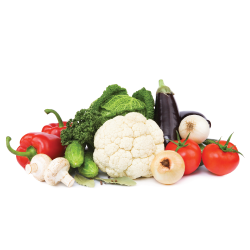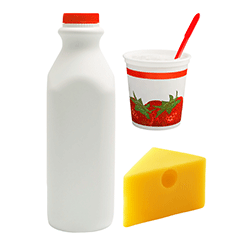Fiber found in fruit is associated with which of the following health outcomes?
Strengthening bones
Making new blood cells
Building muscle
Maintaining proper bowel function
As a part of an overall healthy diet, eating foods that contain fiber – such as fruits, vegetables, and whole grains – may reduce risk for heart disease, protect against certain types of cancer, and help maintain proper bowel function.
You should only eat raw vegetables because if you cook vegetables, all of the vitamins are "cooked away."
True
False
Cooked vegetables still contain vitamins, minerals, and fiber and can be very nutritious – but remember that sauces or seasonings used in cooking can add calories, saturated fat, and/or sodium to vegetables.
Refined grains are grains that have been milled, a process that removes the bran and germ. This is done to give grains a finer texture and improve their shelf life, but it also removes dietary fiber, iron, and many B vitamins. Which of these foods is a refined grain?
Oatmeal
Bulgur (cracked wheat)
White rice
Popcorn
All of the above
White rice is a refined grain. Choose brown rice, wild rice, or quinoa for a whole grain alternative to white rice.
What type of milk is recommended for adults?
Fat-free (skim)
Buttermilk (full fat)
Reduced fat (2%)
Whole milk
Fat-free (skim) milk has all of the vitamins, minerals, and protein found in whole milk or other reduced fat milks, but with less solid fat and thus fewer calories. Low-fat (1%) milk is also recommended for adults.
Nuts and seeds are good sources of what?
Protein
Dietary fiber
Minerals
Vitamin E
All of the above
Nuts and seeds are good sources of protein, dietary fiber, minerals, and vitamin E.
Fruits are sources of which of the following?
Folate
Vitamin D
Calcium
Protein
Folate is one of the B vitamins and is needed by all of our cells for growth. Although vitamin D and calcium are not typically found in high amounts in fruits, you can find some 100% orange juices that are fortified with calcium and vitamin D. You’ll commonly see this advertised on the front of the container.
What color vegetable should you eat the most?
Orange they taste best
Purple they're rare and exotic
Green because kale is green
A variety of colors
Varying your veggies ensures you get many different vitamins and minerals.
The Grains Group could also be called the Carbohydrate Group because all foods that contain carbohydrates are in the Grains Group.
Though carbohydrates (“carbs”) are present in all foods in the Grains Group, carbohydrates are also present in the other MyPlate food groups (fruits, vegetables, proteins, and dairy foods) as dietary fibers, sugars, and starches.
What type of milk is recommended for infants less than 6 months old?
Fat-free (skim)
Low fat (1%)
Reduced fat (2%)
Whole milk
None of these milks are recommended.
Whole milk
None of these milks are recommended.
While milk contains beneficial nutrients for children, it is recommended that infants up to 6 months old get all of their nutrition from breast milk or formula. The amounts of protein, sodium, and potassium in cow’s milk are too high for infants. Also, plain milk does not have as many nutrients as breast milk or infant formula and this can affect a baby’s growth and development.
What are these? 
Pistachios
Almonds
Peanuts
Hazelnuts
These are almonds. Choose unsalted, raw, or dry-roasted nuts as a source of protein.
Which of these foods is actually a fruit in plant biology?
Onion
Pepper
Mushrooms
All of the above
In plant biology, a fruit contains the seeds of a plant. Though it is botanically a fruit, a pepper counts toward the Vegetable Group because we eat peppers in a similar way to vegetables (on sandwiches, in soups, in pasta sauces). Likewise, tomatoes, squash, cucumbers, and pumpkins all contain the seeds of the plant and are therefore botanically fruits.
Which of these foods is actually a fruit in plant biology?
Tomatoes
Sweet onions
Peas
Kale
In plant biology, a fruit contains the seeds of a plant. Though it is botanically a fruit, tomatoes count toward the Vegetable Group because we eat tomatoes in a similar way to vegetables (on sandwiches, in soups, in pasta sauces). Likewise, peppers, squash, cucumbers, and pumpkins all contain the seeds of the plant and are therefore botanically fruits.
Many people do not eat the recommended amount of whole grains. To eat more whole grain foods, you should just add more of them to what you already eat.
True
False
Making some substitutions such as eating whole-wheat bread instead of white bread or having brown rice instead of white rice, can add important whole grains to your diet.
What is the name of the sugar found naturally in milk?
Fructose
Lactose
Glucose
Sucrose
Lactose is the sugar found naturally in milk. Be aware that flavored milk contains added sugar.
Foods in the Protein Foods Group provide protein, but which of these foods from that group is also a source of calcium?
Peas
Sardines
Chicken
Ham
Eating canned fish with the bones, like sardines or anchovies, provides you with calcium. Because the bones are soft, they are edible.
Which of these foods is a source of vitamin C?
Pineapples
Strawberries
Oranges
All of the above
All fruits (and vegetables, too) contain some amount of vitamin C – an important nutrient that is needed for the growth and repair of tissues in all parts of your body.
What food group are beans, peas, and lentils counted in?
Vegetable group
Protein group
Both
All of the above
Neither
Beans, peas, and lentils can be counted in either food group because they contain nutrients that are similar to foods in the Vegetable Group (fiber, potassium, and folate) and the Protein Foods Group (protein, iron, and zinc). Because of their high nutrient content, consuming beans, peas, and lentils is recommended for everyone, including people who also eat meat, poultry, and seafood regularly.
About how much of the grains you eat should be whole grains?
None
One quarter
One half
All of them
"Make at least half your grains whole grains" is a key nutrition message of MyPlate and the Dietary Guidelines for Americans. Among several other nutrients -- such as selenium and B vitamins -- whole grains provide fiber which has been linked to reducing blood levels of cholesterol, which reduces heart disease risk.
Which of these dairy products contains a healthy bacteria (also called “probiotics”)?
Milk
Cheese
Yogurt
Ice Cream
Certain specific bacteria are added in the process of making yogurt from fluid milk.Yogurts that contain probiotics will say “live and active cultures” on the package.
Eat seafood in place of meat or poultry twice a week.
True
False
You should select a variety of seafood and include some that are higher in oils and low in mercury, such as salmon, trout, and herring.
What do fruits have that make them sweet? 
Vitamin C
Fiber
Fructose
Protein
Pleasing or agreeable personalities
Fructose is a natural sugar found in fruit that is responsible for the sweet flavor of many fruits.
Carrots, onions, and sweet potatoes are all vegetables and are what part of a plant?
Seeds
Flower
Root
Stem
These are all "root vegetables"; the part you eat is grown underground.
Which of these grain products is available in both refined and whole grain varieties?
Pasta
Bread
Cornbread
Crackers
All of the above
All of these grain products are available in both refined and whole grain varieties. Check the ingredient list for terms like "whole grain", "whole cornmeal", or "whole wheat" to help you choose food products made from whole grains. Some foods are made from a mixture of whole grains and refined grains.
Which of these is a calcium option for people who are lactose intolerant?
Lactose-free milk
Calcium-fortified soy milk
Yogurt and some cheeses
Kale and collard greens
All of the above
All of the options above contain little or no lactose and can therefore help decrease the symptoms of lactose intolerance, while still providing necessary calcium.
Should you wash or rinse raw meat or poultry before you cook it?
Yes
No
Do not wash or rinse raw meat or poultry before you cook it. Washing can cause bacteria found on the surface of meat or poultry to be spread to ready-to-eat foods, kitchen utensils, and counter surfaces. This is called cross-contamination. Cooking (baking, broiling, boiling, and grilling) to the right temperature kills the bacteria.